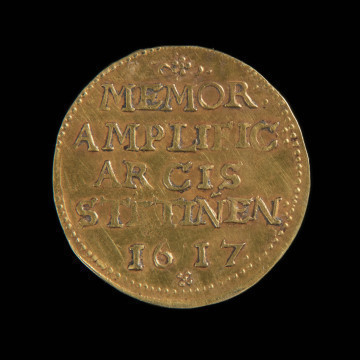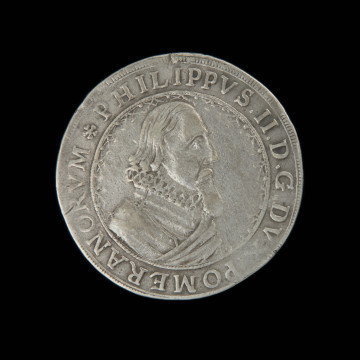
Commemorative guilder
1615
National Museum in Szczecin
Part of the collection: Pomeranian coins
The true blossoming of occasional issues took place during the reign of the Duke of Szczecin, Philip II (1606-1618). The ruler's love for art translated into a passion for collecting coins and designing his ones. The series of coins created towards the end of his reign (1614-1618) reflect the then events and political situation and the ideology of his rule (the so-called Regierungskunst). The presented thaler refers to the dangerous riots in Szczecin in July 1616, following the announcement of increased charges for imported goods and the rise in beer prices (from 12 to 16 groszy per quart). The Duke put an end to the rebellion peacefully by restoring former prices of the beverage, and a special commission prepared a project of reforming the city's finances. To commemorate those events, a series of silver and gold coins were minted, often wrongly linked to the Reformation jubilee because of the date of the issue (1617). In the thaler's composition, the allegoric image of a sailing boat as the Duchy of Pomerania comes to the fore, together with the inscription SAPIENTIA NON VIOLENTIA (wisdom not violence) acquires a political meaning in the face of an extraordinary situation. It expresses the conviction that despite the adversities experienced, there is a prudent and wise ruler at the helm who will protect against collapse or dismemberment. The Duke’s portrait in armour does not deviate from the conventional profile but differs in details. There is a lion's head on the arm, thanks to which the ruler became a symbolically invincible Hercules, taking on the positive features of the ancient hero. Although the thaler is not signed, we can assume with a high degree of probability that it was made by Daniel Sailer, an Augsburg goldsmith, who worked at the mint as an engraver. Another type of the thalers has a stamp with a boat combined with another obverse (Philip II's bust in a bordure) signed by the artist. Both series of thalers have their prints worth half a thaler, as well as double and triple thalers. The museum copy comes from the Pomeranian collection of Prof. Helmut Hahn, which was sold at auction in Berlin in 2013. Its previous owner was the pre-war collector Karl Ludwig Grabow, who personally auctioned off his Pomeranian collection in 1930.
Genowefa Horoszko
Author / creator
Dimensions
cały obiekt: height: 2.4 mm
Object type
commemorative coin
Technique
minting
Material
silver
Creation time / dating
Creation / finding place
Owner
National Museum in Szczecin
Identification number
Location / status

1615
National Museum in Szczecin

1617
National Museum in Szczecin

1618
National Museum in Szczecin
DISCOVER this TOPIC
Castle Museum in Łańcut
DISCOVER this PATH
Educational path